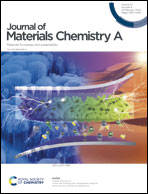A gradient hexagonal-prism Fe3Se4@SiO2@C configuration as a highly reversible sodium conversion anode†
Abstract
Metal selenides have attracted great interest for high-efficiency sodium storage owing to their remarkable advantages of physicochemical features and electrochemical activity. However, substantial issues (e.g. poor intrinsic conductivity, severe interfacial side reactions and electrode structural destruction) in the electrochemical storage process restrict their practical feasibility and commercial prospects. Herein, a gradient hexagonal-prism configuration was exquisitely designed and developed via in situ conformal growth of double-shell silicon dioxide/carbon (SiO2@C) reactors on highly uniform Fe-based MIL-88A nanorods and subsequent selenization–carbonization treatment (Fe3Se4@SiO2@C). In the ingeniously designed Fe3Se4@SiO2@C nanorods, the outer double-shell SiO2@C reactors as charge-transfer and deformation-defense layers provide excellent ionic permeability and efficient charge-transfer channels and meanwhile endow superb resistance of volume variation, whereas the inner Fe3Se4 nanorods as a sodium-storage layer feature ample active sites for enhancing reversible capacity and satisfying surface-driven capacitive behaviors. Motivated by its distinctive structure and favorable properties, Fe3Se4@SiO2@C is tremendously conducive to efficient sodium storage, as corroborated by its excellent rate capability and extraordinary stability with an ultrahigh reversible capacity of 272 mA h g−1 at 20.0 A g−1 after 4200 cycles; these results obviously outperform those of the contrast samples Fe3Se4@SiO2 and single Fe3Se4@C as well as other reported Fe-based selenides. The conjunct exploration of ex situ structural characterizations strongly revealed a combination mechanism of intercalation and conversion from Fe3Se4 to the intermediate NaxFe3Se4 and the final states NaxSe/Fe. More interestingly, a Fe3Se4@SiO2@C//Na3V2(PO4)3@C full cell configuration enables a considerably high capacity of 241 mA h g−1 at 1.0 A g−1 after 100 cycles, revealing great practical feasibility in energy storage systems.



 Please wait while we load your content...
Please wait while we load your content...